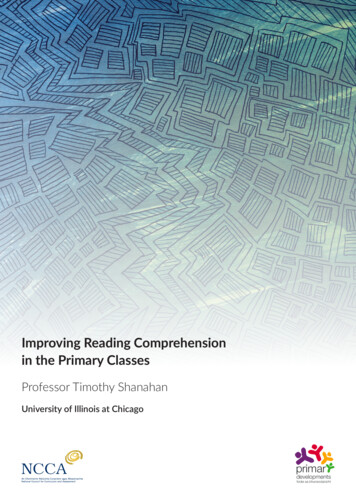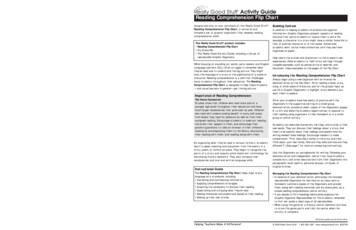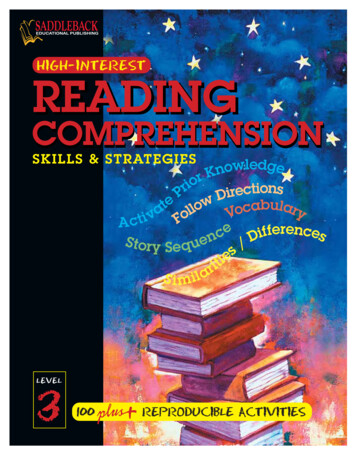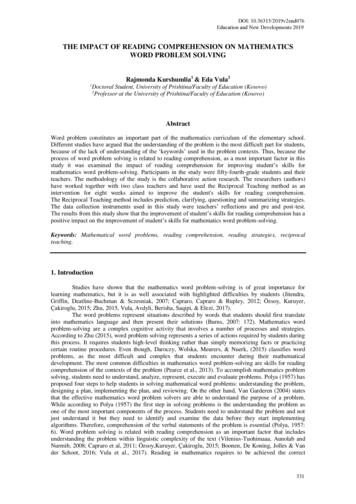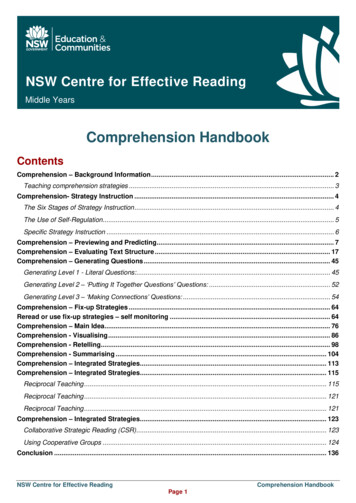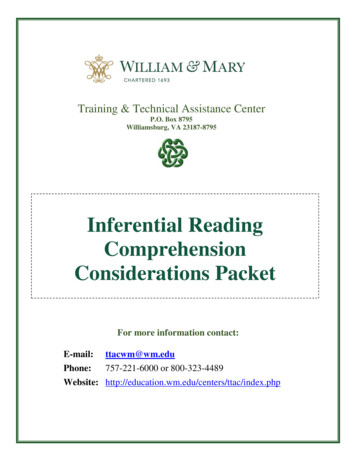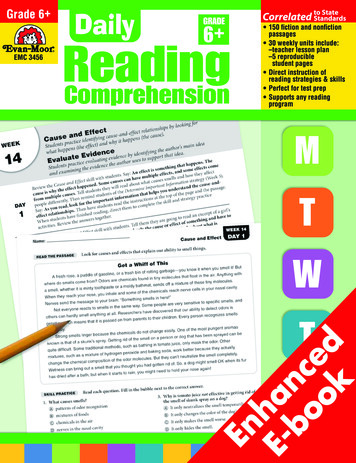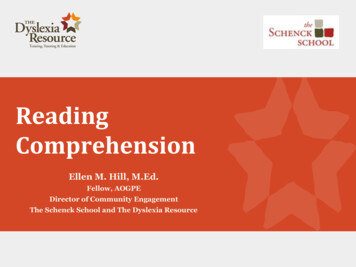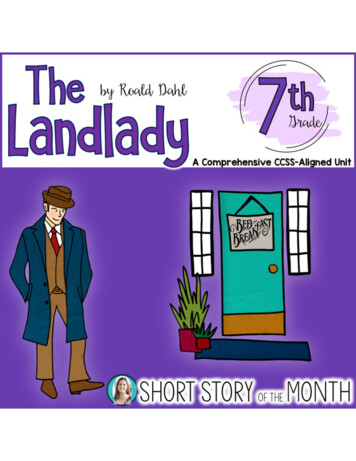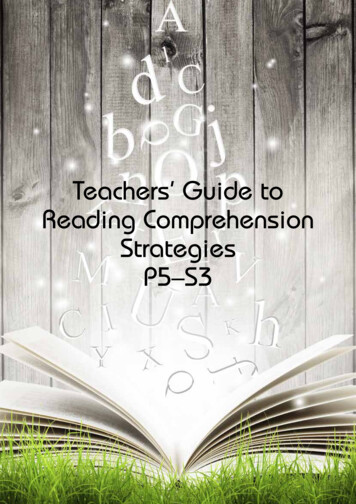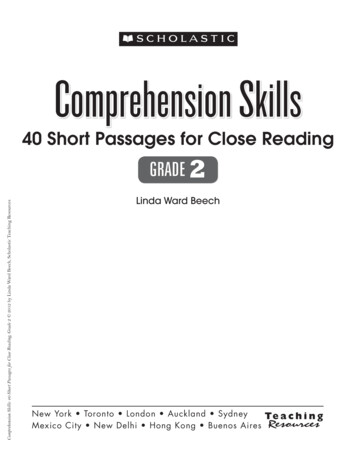
Transcription
Comprehension Skills40 Short Passages for Close ReadingComprehension Skills: 40 Short Passages for Close Reading, Grade 2 2012 by Linda Ward Beech, Scholastic Teaching ResourcesGRADE 2Linda Ward BeechNew York Toronto London Auckland SydneyMexico City New Delhi Hong Kong Buenos Aires
The reading passages in this book were selected and adapted from the following titles in the series,Reading Passages That Build Comprehension: Compare & Contrast, Context Clues, Fact & Opinion, Inference,Main Idea & Details, and Predicting. (Scholastic, 2005). Copyright 2005 by Linda Ward Beech.Cover design by Jorge J. NamerowInterior design by Jason RobinsonIllustrations by Mike GordonISBN: 978-0-545-46053-8Text copyright 2012 by Linda Ward BeechIllustrations copyright 2012 by Scholastic Inc.Published by Scholastic Inc.All rights reserved.Printed in the U.S.A.1 2 3 4 5 6 7 8 9 104019 18 17 16 15 14 13 12Comprehension Skills: 40 Short Passages for Close Reading, Grade 2 2012 by Linda Ward Beech, Scholastic Teaching ResourcesThe reproducible pages in this book may be reproduced for classroom use.No part of this publication may be reproduced in whole or in part, or stored in a retrieval system, or transmittedin any form or by any means, electronic, photocopying, recording, or otherwise, without written permission ofthe publisher. For information regarding permission, write toScholastic Inc., 557 Broadway, New York, NY 10012.
ContentsUsing This Book. . . . . . . . . . . . . . . . . . . . . . . . . . . . . . . . . . . . . . . . . . . . . . . . . . . . . . . . 4Comprehension Skills At-a-Glance. . . . . . . . . . . . . . . . . . . . . . . . . . . . . . . . . . . . . . . . . 4Meeting the Common Core State Standards. . . . . . . . . . . . . . . . . . . . . . . . . . . . . . . . . 6Comprehension Skills: 40 Short Passages for Close Reading, Grade 2 2012 by Linda Ward Beech, Scholastic Teaching ResourcesPassages1. Rob’s Job. . . . . . . . . . . . . . . . . . . . . 72. A Gardener’s Friend . . . . . . . . . . . . 822. Marc Brown. . . . . . . . . . . . . . . . . 2823. Frogs and Toads . . . . . . . . . . . . . 293. A Tale of Tails. . . . . . . . . . . . . . . . . . 94. A Mark on the Wall . . . . . . . . . . . 1024. News in the Past. . . . . . . . . . . . . 3025. From Canada to Mexico . . . . . . . 315. Meet Mercury . . . . . . . . . . . . . . . 116. Ellen’s Saturday. . . . . . . . . . . . . . 1226. Shape of a Plate. . . . . . . . . . . . . 3227. Remembering Stories. . . . . . . . . 337. School Zoo. . . . . . . . . . . . . . . . . . 138. Birds and Turtles. . . . . . . . . . . . . 1428. Don’s Flower . . . . . . . . . . . . . . . . 3429. Whales in Water . . . . . . . . . . . . . 359. A Smart Fish . . . . . . . . . . . . . . . . 1510. Horse Helpers. . . . . . . . . . . . . . . 1630. A Busy Cactus. . . . . . . . . . . . . . . 3631. Pumpkins in History . . . . . . . . . . 3711. Kinds of Leaves. . . . . . . . . . . . . . 1712. Raisin Capital . . . . . . . . . . . . . . . 1832. Corn Maze. . . . . . . . . . . . . . . . . . 3833. Firehouse Dogs. . . . . . . . . . . . . . 3913. Ship of the Desert. . . . . . . . . . . . 1914. Nest Soup . . . . . . . . . . . . . . . . . . 2034. Pigs and Bears . . . . . . . . . . . . . . 4035. Cabin Cleanup. . . . . . . . . . . . . . . 4115. Using Plants. . . . . . . . . . . . . . . . . 2116. Beatrix Potter. . . . . . . . . . . . . . . . 2236. Staying Warm. . . . . . . . . . . . . . . . 4137. Dolphin Teamwork. . . . . . . . . . . . 4317. Two Apples. . . . . . . . . . . . . . . . . . 2318. Night Life. . . . . . . . . . . . . . . . . . . 2438. On the Food Trail. . . . . . . . . . . . . 4439. Thanksgiving Customs. . . . . . . . 4519. Animals of the Arctic. . . . . . . . . . 2520. Slurp and Burp!. . . . . . . . . . . . . . 2640. Setting the Table. . . . . . . . . . . . . 4621. Cara’s Cat . . . . . . . . . . . . . . . . . . 27Answers . . . . . . . . . . . . . . . . . . . . . . . 47
Using This BookPassageReading comprehension in nonfiction involves numerous thinkingskills. Students require these skills to make sense of a text andbecome successful readers. This book offers practice in key skillsneeded to meet the Common Core State Standards in Reading/Language Arts for grade two. (See page 6 for more.) Each studentpage includes a short passage focusing on three of these essentialcomprehension skills.5Name DateRead the paragraph. Then answer the questions.Meet MercuryComprehension Skills At-a-Glance1. The main idea of the paragraph isA. the lack of water on Mercury.B. the planets in the solar system.C. what the planet Mercury is like.Use the information that follows to introduce the readingcomprehension skills covered in this book.2. A detail that tells more about the main idea isA. the speed at which Mercury travels around the Sun.B. the names of the other planets in the solar system.C. how fast other planets in the solar system travel.3. Write one way that Mercury differs from other planets.Main Idea & DetailsUnderstanding the main or key idea of a paragraph is crucial fora reader. The main idea is what the paragraph is about. The otherparts of the paragraph help to explain more about this key idea.Sometimes, the main idea is in the first sentence of a paragraph.111. Main Idea 2. Details 3. Compare & ContrastIn this paragraph, students have to readthe entire text and ask themselves, “Whatis this paragraph mainly about?” The mainidea is supported by different factsabout Mercury.PassageThe information that supports the main idea is usually referred to asthe details. Details help a reader gain a fuller understanding ofa paragraph.2Name DateContext CluesUsing context means determining an unfamiliar word’s meaningby studying the phrases, sentences, and overall text with which theword appears. Context clues help readers comprehend and enjoy atext and also read more smoothly and efficiently.Read the paragraph. Then answer the questions.A Gardener’s FriendWhat do ladybugs eat? Their main foodis a tiny insect called an aphid.Most gardeners think of aphids as pests.These insects cause harm to plantsby sucking out their juices.When people see ladybugs in their gardens,however, they are pleased.A. Gardeners will get rid of the ladybugs.B. The ladybugs will eat the aphids.C. The aphids will attack the ladybugs.2. In this paragraph the word pests must meanA. troublemakers.B. plants.C. helpers.3. How are ladybugs and aphids different?1. Predict 2. Context Clues 3. Compare & Contrast8Comprehension Skills: 40 Short Passages for Close Reading, Grade 2 2012 by Linda Ward Beech, Scholastic Teaching Resources1. Which sentence tells what most likely happens next?Compare & ContrastRecognizing how events, characters, places, and facts are alikeand different helps a reader gain a richer understanding of a text.Sometimes a reader can learn more about something by findingout what it is not like than what it is like. A comparison showssimilarities, while a contrast shows differences.In this example, other words in theparagraph provide a context forcomprehending the word pests.4Comprehension Skills: 40 Short Passages for Close Reading, Grade 2 2012 by Linda Ward Beech, Scholastic Teaching ResourcesComprehension Skills: 40 Short Passages for Close Reading, Grade 2 2012 by Linda Ward Beech, Scholastic Teaching ResourcesCan you name the planets in our solar system?Mercury is one of them. Like the other planets,Mercury moves in a path around the Sun.Mercury travels faster than the other planets.It speeds along at about 107,000 miles an hour.Mercury is the planet closest to the Sun.Its days are very hot, and its nights are very cold.There is no water on Mercury.
Passage21Name DateRead the paragraph. Then answer the questions.Cara’s Cat1. In this paragraph, the word shreds must meanA. rolls.B. pieces.C. squares.2. You can predict that when she saw the mess, CaraA. hugged Honey.B. was mad at Honey.C. got a new cat.3. You can guess that HoneyA. didn’t like Cara’s family.B. liked to have people around.C. wanted to please Cara.271. Context Clues 2. Predict 3. InferenceThe writer never says that the cat likes tohave people around, but information inthe paragraph plus what readers alreadyknow helps make it a likely guess.Passage14Name DateFact & OpinionReaders who can identify and differentiate between statements offact and opinion are better able to analyze and assess a text. Studentsshould learn to recognize phrases, such as I think and you should, thatsignal opinions.Read the paragraph. Then answer the questions.Nest SoupBirds called swifts are popular in Thailand.People there welcome the birds into their homes.In one city the birds even live in a hotel.The reason the birds are in such demandis their nests. Bird’s nest soup is a big treatin Thailand. I don’t think I would care for it.Vegetable soup seems better to me!1. Write fact or opinion next to each sentence.A. Birds called swifts are popular in Thailand.B. I don’t think I would care for it.C. In one city the birds even live in a hotel.2. In this paragraph, the word popular meansA. disliked.B. useful.C. liked.3. Write another opinion from the paragraph.1. Fact & Opinion 2. Context Clues 3. Fact & Opinion20To appreciate this story, the reader shouldunderstand that the writer has sharedseveral opinions as well as some factsabout the bird’s nest soup.TipsH Tell students to first readthe passage and then answerthe questions. Show them howto fill in the circles for bubbletest questions.H The comprehension skillstargeted in the questionsaccompanying each passageare labeled at the bottom ofthe page.5H Review the completed pageswith students on a regularbasis. Encourage them toexplain their thinking for eachcorrect answer.Comprehension Skills: 40 Short Passages for Close Reading, Grade 2 2012 by Linda Ward Beech, Scholastic Teaching ResourcesComprehension Skills: 40 Short Passages for Close Reading, Grade 2 2012 by Linda Ward Beech, Scholastic Teaching ResourcesInferenceAlthough most primary students don’t know what an inference is,many are most likely making inferences—both in their daily livesand when reading—without being aware of it. Students shouldunderstand that writers don’t include every detail in their writing; itis up to readers to supply some information. A reader makes a guessor inference by putting together what is in a text with what he or shealready knows. Inferring makes a significant difference in how mucha reader gains from a text.Comprehension Skills: 40 Short Passages for Close Reading, Grade 2 2012 by Linda Ward Beech, Scholastic Teaching ResourcesPredictGood readers take time to think about a text. One way they do thisis by thinking ahead to determine what may happen next or how anevent will unfold. Often, information a reader has come across in thetext provides clues to what will happen next. In many cases readersalso use what they already know when they make predictions.Cara’s cat didn’t like to be left alone.Cara never knew what Honey would do whenthe family was out. Sometimes the cat just slept.But sometimes she was bad. One day Carafound a big mess in the bathroom.Honey had unrolled the toilet paper.It was in shreds. Bits of it were everywhere.It took a long time to clean up Honey’s mess.
Meeting the Common Core State StandardsThe passages and comprehension questions in this book are designed to help you meet both yourspecific English/Language Arts standards and learning expectations as well as those recommended bythe Common Core State Standards Initiative (CCSSI). The activities in this book align with the followingCCSSI standards for grade two.Key Ideas and DetailsReading Standards for Literature1. Ask and answer such questions as who, what, where, when, why, and how to demonstrateunderstanding of key details in a text.3. Describe how characters in a story respond to major events and challenges.Craft and Structure5. Describe the overall structure of a story, including describing how the beginningintroduces the story and the ending concludes the action.Integration of Knowledge and Ideas7. Use information gained from the illustrations and words in a print text to demonstrate understandingof its characters, setting, or plot.Range of Reading and Level of Text Complexity10. By the end of the year, read and comprehend literature, including stories, in the grades 2–3 textcomplexity band proficiently, with scaffolding as needed at the high end of the range.Reading Standards for Informational TextKey Ideas and DetailsCraft and Structure4. Determine the meaning of words and phrases in text relevant to a grade 2 topic or subject area.6. Identify the main purpose of a text, including what the author wants to answer, explain, or describe.Integration of Knowledge and Ideas8. Describe how reasons support specific points the author makes in a text.Range of Reading and Level of Text Complexity10. By the end of the year, read and comprehend informational texts, including history/social studies,science, and technical texts, in the grades 2–3 text complexity band proficiently, with scaffolding asneeded at the high end of the range.FluencyReading Standards: Foundational Skills4. Read with sufficient accuracy and fluency to support comprehension.a. Read on-level text with purpose and understanding.c. Use context to confirm or self-correct word recognition and understanding,rereading as necessary.Knowledge of LanguageLanguage Standards3. Use knowledge of language and its conventions when writing, speaking, reading, or listening.Vocabulary Acquisition and Use4. Determine or clarify the meaning of unknown and multiple-meaning words and phrases based ongrade 2 reading and content, choosing flexibly from an array of strategies.a. Use sentence-level context as a clue to the meaning of a word or phrase.5. Demonstrate understanding of word relationships and nuances in word meanings.b. Distinguish shades of meaning among closely related verbs.6. Use words and phrases acquired through conversations, reading and being read to,and responding to texts.6Comprehension Skills: 40 Short Passages for Close Reading, Grade 2 2012 by Linda Ward Beech, Scholastic Teaching Resources1. Ask and answer such questions as who, what, where, when, why, and how to demonstrateunderstanding of key details in a text.3. Describe the connection between a series of historical events, scientific ideas or concepts, or stepsin technical procedures in a text.
Passage1Name DateRead the paragraph. Then answer the questions.Rob’s JobThe Dells had a big fireplace. On snowywinter days they often lit a fire. Rob’s jobwas to make sure there was plentyof wood to burn. He would take his sledto the woodshed. There he loaded logsonto the sled. Then he would haul the wood backComprehension Skills: 40 Short Passages for Close Reading, Grade 2 2012 by Linda Ward Beech, Scholastic Teaching Resourcesto the house and bring it in to burn.1. In this paragraph, the word haul must meanA. chop.B. pull.C. burn.2. The main idea of this paragraph isA. why Rob had a sled.B. snowy winter days.C. getting wood for a fireplace.3. How do you think the Dells feel about their fireplace?71. Context Clues 2. Main Idea 3. Inference
Passage2Name DateRead the paragraph. Then answer the questions.A Gardener’s FriendWhat do ladybugs eat? Their main foodis a tiny insect called an aphid.Most gardeners think of aphids as pests.These insects cause harm to plantsby sucking out their juices.When people see ladybugs in their gardens,however, they are pleased.A. Gardeners will get rid of the ladybugs.B. The ladybugs will eat the aphids.C. The aphids will attack the ladybugs.2. In this paragraph the word pests must meanA. troublemakers.B. plants.C. helpers.3. How are ladybugs and aphids different?1. Predict 2. Context Clues 3. Compare & Contrast8Comprehension Skills: 40 Short Passages for Close Reading, Grade 2 2012 by Linda Ward Beech, Scholastic Teaching Resources1. Which sentence tells what most likely happens next?
Passage3Name DateRead the paragraph. Then answer the questions.A Tale of TailsPigs are known for having curly tails.They’re so cute! Experts say that you can tellhow healthy a pig is by the curl of his tail.A pig with a curly tail is in good health.But a pig with a straight tail is not. Poor pig.A straight tail on a pig is a sign of illness.Farmers should take good care of their pigsComprehension Skills: 40 Short Passages for Close Reading, Grade 2 2012 by Linda Ward Beech, Scholastic Teaching Resourcesso they don’t get sick.1. Write fact or opinion next to each sentence.A. They’re so cute!B. Experts say that you can tell how healthy a pig isby the curl of its tail.C. A straight tail on a pig is a sign of illness.2. Which sentence is most likely true?A. Pigs like to wag their tails.B. Pigs always get sick.C. Farmers check their pigs’ tails often.3. What will a farmer most likely do if a pig’s tail is straight?91. Fact & Opinion 2. Inference 3. Predict
Passage4Name DateRead the paragraph. Then answer the questions.A Mark on the WallAnna took off her shoes. She stood straightwith her back against the wall. Anna’s motherput the ruler on Anna’s head and made a little markon the wall. It was two inches above another mark.Next to the new mark, Anna’s mother wrote the date.“Wow!” she said. “No wonder your jeans are too short.”1. Which sentence is most likely true?B. Anna’s mother is mad at Anna.C. Anna has grown two inches taller.2. You can guess that the next mark will beA. the same.B. lower.C. higher.3. Most likely Anna’s mother willA. buy Anna new jeans.B. give Anna old jeans.C. make Anna stop growing.1. Inference 2. Predict 3. Predict10Comprehension Skills: 40 Short Passages for Close Reading, Grade 2 2012 by Linda Ward Beech, Scholastic Teaching ResourcesA. Anna’s mother is measuring Anna’s head.
Passage5Name DateRead the paragraph. Then answer the questions.Meet MercuryComprehension Skills: 40 Short Passages for Close Reading, Grade 2 2012 by Linda Ward Beech, Scholastic Teaching ResourcesCan you name the planets in our solar system?Mercury is one of them. Like the other planets,Mercury moves in a path around the Sun.Mercury travels faster than the other planets.It speeds along at about 107,000 miles an hour.Mercury is the planet closest to the Sun.Its days are very hot, and its nights are very cold.There is no water on Mercury.1. The main idea of the paragraph isA. the lack of water on Mercury.B. the planets in the solar system.C. what the planet Mercury is like.2. A detail that tells more about the main idea isA. the speed at which Mercury travels around the Sun.B. the names of the other planets in the solar system.C. how fast other planets in the solar system travel.3. Write one way that Mercury differs from other planets.111. Main Idea 2. Details 3. Compare & Contrast
Passage6Name DateRead the paragraph. Then answer the questions.Ellen’s SaturdayWhen Ellen wakes up on Saturday,there is snow on the ground.Ellen races through her breakfast.Then she pulls on a hat, jacket, and gloves.Her boots are not in the closet,so she runs outside in her sneakers.She joins her friends to go sledding.A. Ellen’s feet will get cold and wet.B. Ellen will lose her sled on the hill.C. Ellen’s friends will take off their boots.2. You can tell that Ellen lovesA. breakfast.B. snow.C. boots.3. In this paragraph, the word races meansA. rushes.B. drags.C. runs.1. Predict 2. Inference 3. Context Clues12Comprehension Skills: 40 Short Passages for Close Reading, Grade 2 2012 by Linda Ward Beech, Scholastic Teaching Resources1. Which sentence tells what most likely happens next?
Passage7Name DateRead the paragraph. Then answer the questions.School ZooComprehension Skills: 40 Short Passages for Close Reading, Grade 2 2012 by Linda Ward Beech, Scholastic Teaching ResourcesMany classrooms have pets. This is the bestway for students to learn about animals.But classroom pets need a place to goduring the summer. In Plano, Texas, the schoolshave a mini-zoo. Teachers can borrow petsfor the school months. When summer comes,they return the pets to the zoo. Schools inother towns should follow this example.1. Write fact or opinion next to each sentence.A. This is the best way for students to learn about animals.B. In Plano, Texas, the schools have a mini-zoo.C. Schools in other towns should follow this example.2. You can guess thatA. the pets dislike being in the classroom.B. there is no school in the summer.C. the zoo closes in the summer.3. In this paragraph, the word borrow meansA. have forever.B. have for awhile.C. pay money for.131. Fact & Opinion 2. Inference 3. Context Clues
Passage8Name DateRead the paragraph. Then answer the questions.Birds and Turtles1. How are birds and turtles alike?A. They have hard shells.B. The young hatch from eggs.C. The mothers leave the eggs.2. How are birds and turtles different?A. Bird parents feed their young.B. They lay eggs in safe places.C. The young need food to eat.3. In this paragraph, the word hatch meansA. opening on a roof.B. make a plan.C. come out of.1. Compare & Contrast 2. Compare & Contrast 3. Context Clues14Comprehension Skills: 40 Short Passages for Close Reading, Grade 2 2012 by Linda Ward Beech, Scholastic Teaching ResourcesMother birds lay eggs in nests where they are safe.Little birds hatch from the eggs.They cheep and cheep until their parentsbring them food. Turtles lay eggs, too.Mother turtles lay their eggs in the sandwhere the eggs will be safe. But mother turtlescover the eggs and leave. When it is time,small turtles hatch from the eggs. They digtheir way up and learn to find food on their own.
Passage9Name DateRead the paragraph. Then answer the questions.A Smart FishComprehension Skills: 40 Short Passages for Close Reading, Grade 2 2012 by Linda Ward Beech, Scholastic Teaching ResourcesFred was a very smart fish. He lived ina peaceful river. Nothing much happenedthere unless people came around.Then Fred had to be alert.A yummy worm might mean a trap.If Fred wasn’t careful, he could end up as someone’s supper.He had seen it happen to many careless fish.1. In this paragraph, the word alert must meanA. watchful.B. careless.C. sleepy.2. You can guess that a worm Fred saw might beA. on a fishing pole.B. in the ground.C. on a water lily.3. If Fred saw a worm, you can predict he wouldA. eat it quickly.B. swim away.C. try to save it.151. Context Clues 2. Inference 3. Predict
Passage10Name DateRead the paragraph. Then answer the questions.Horse HelpersHorses are wonderful helpers for humans.In some cities the police ride horsesto control large crowds. Cowboys use horsesto help round up herds of cattle. In somecountries farmers still use horses to pullplows or wagons. People also use horsesto carry them from place to place.A. the different jobs that horses can do.B. how the police use horses in crowds.C. the ways that animals help people.2. A detail that tells more about the main idea isA. how cowboys use horses in their work.B. the kinds of horses used in police work.C. the names of countries using farm horses.3. Write fact or opinion next to each sentence.A. Cowboys use horses to help round up herds of cattle.B. Horses are wonderful helpers for humans.C. People also use horses to carry them from place to place.1. Main Idea 2. Details 3. Fact & Opinion16Comprehension Skills: 40 Short Passages for Close Reading, Grade 2 2012 by Linda Ward Beech, Scholastic Teaching Resources1. The main idea of the paragraph is
Passage11Name DateRead the paragraph. Then answer the questions.Comprehension Skills: 40 Short Passages for Close Reading, Grade 2 2012 by Linda Ward Beech, Scholastic Teaching ResourcesKinds of LeavesThe leaves on trees are not all alike.Some leaves have jagged edges called teeth.Toothed leaves can be oval, skinny,or shaped like a heart. Beech and elm treeshave such leaves. Other trees have leavesshaped like a hand with the fingers spread out.These leaves have three to seven fingers,also called lobes. Many maple trees have such leaves.Both types of leaves drop off trees in the fall.1. How are toothed leaves and hand-shaped leaves alike?A. They grow on trees.B. They have lobes.C. They have teeth.2. How are toothed leaves and hand-shaped leaves different?A. Maple leaves drop off in the fall.B. Elm leaves are shaped like hands.C. Toothed leaves have jagged edges.3. The main idea of this paragraph isA. trees have different kinds of leaves.B. maples trees have hand-shaped leaves.C. beech trees have jagged edges.171. Compare & Contrast 2. Compare & Contrast 3. Main Idea
Passage12Name DateRead the paragraph. Then answer the questions.Raisin CapitalCalifornia is the raisin capital of the world.Farmers there begin by growing grapes.When the grapes are ripe, workers pick themfrom the vine. Then the grapes are laid out inCalifornia’s dry, sunny air. The grapes beginto get wrinkled as they lose their water.They change color, too.A. The grapes get moldy and rotten.B. Farmers water the dry grapes.C. The grapes turn into raisins.2. You can guess that grapes grow well becauseA. they grow on vines.B. of California’s dry, sunny air.C. California is the raisin capital.3. In this paragraph, the word ripe meansA. wrinkled.B. picked.C. full-grown.1. Predict 2. Inference 3. Context Clues18Comprehension Skills: 40 Short Passages for Close Reading, Grade 2 2012 by Linda Ward Beech, Scholastic Teaching Resources1. Which sentence tells what most likely happens next?
Passage13Name DateRead the paragraph. Then answer the questions.Ship of the DesertComprehension Skills: 40 Short Passages for Close Reading, Grade 2 2012 by Linda Ward Beech, Scholastic Teaching ResourcesDo you know what a ship of the desert is?It is a camel. These animals are goodfor carrying people and supplies across hot,dry deserts. Camels can go many dayswithout getting thirsty. Camels can also gofor a long time without food. They live off the fatin their humps when there is no food.1. Which sentence is most likely true?A. Camels eat sand most of the time.B. Camels don’t like to eat or drink.C. The desert has little food or water.2. You can guess that some trips camels makeA. take many days.B. are in cold places.C. are across the sea.3. After a camel crosses a desert, you can predict that itA. isn’t very hungry.B. drinks a lot of water.C. acts like a ship.191. Inference 2. Inference 3. Predict
Passage14Name DateRead the paragraph. Then answer the questions.Nest SoupBirds called swifts are popular in Thailand.People there welcome the birds into their homes.In one city the birds even live in a hotel.The reason the birds are in such demandis their nests. Bird’s nest soup is a big treatin Thailand. I don’t think I would care for it.Vegetable soup seems better to me!A. Birds called swifts are popular in Thailand.B. I don’t think I would care for it.C. In one city the birds even live in a hotel.2. In this paragraph, the word popular meansA. disliked.B. useful.C. liked.3. Write another opinion from the paragraph.1. Fact & Opinion 2. Context Clues 3. Fact & Opinion20Comprehension Skills: 40 Short Passages for Close Reading, Grade 2 2012 by Linda Ward Beech, Scholastic Teaching Resources1. Write fact or opinion next to each sentence.
Passage15Name DateRead the paragraph. Then answer the questions.Using PlantsComprehension Skills: 40 Short Passages for Close Reading, Grade 2 2012 by Linda Ward Beech, Scholastic Teaching ResourcesLong ago, people used plants to makecolorful dyes. They boiled plants in water.Different plants gave off different colors.For example, boiled acorns made a light brown,and beets made a bright pink. The skins fromcertain onions made an orange-colored dye.Once the dyes were ready, people dipped woolor other cloth into them.1. In this paragraph, the word dyes must meanA. stops living.B. colorings.C. foods.2. A good title for this paragraph would beA. Colors From Plants.B. Pink From Beets.C. Orange From Onions.3. You can guess that todayA. vegetables are never used in dyes.B. there are other ways to dye cloth.C. dyes are not as colorful as long ago.211. Context Clues 2. Main Idea 3. Inference
Passage16Name DateRead the paragraph. Then answer the questions.Beatrix PotterBeatrix Potter (1866–1943) loved animals.She also loved to draw. As a young gi
comprehension skills. Comprehension Skills At-a-Glance Use the information that follows to introduce the reading comprehension skills covered in this book. Main Idea & Details Understanding the main or key idea of a paragraph is crucial for a reader. The main idea is what the paragraph is about. The other
